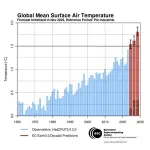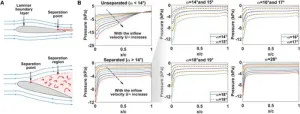2023 has just been confirmed as the hottest year on record, with global average temperatures exceeding pre-industrial conditions by 1.48°C, as stated by the Copernicus Programme of the European Union. Climate scientists from the Barcelona Supercomputing Center-Centro Nacional de Computación (BSC-CNS), based on the BSC decadal forecast system, were capable of predicting a year ago that 2023 had a high probability of being the warmest year on record.
After the record-smashing conditions in 2023, the imminent question is how the year 2024 and the following years will turn out. The recently released decadal forecast reveals that annual global mean surface temperatures in 2024 will probably further exceed those from 2023, and temperatures will continue to increase in the following years as greenhouse gas emissions continue.
The 2024-2033 prediction
Climate scientists of the Climate Variability and Change (CVC) group at the Earth Sciences Department of BSC have recently conducted a decadal forecast for the next ten years, i.e., the 2024-2033 period. The BSC decadal forecast system predicts that the annual global-mean surface temperature for 2024 will be between 1.43-1.69ºC warmer than for pre-industrial levels (defined as the average from 1850 to 1900), with a central estimate of 1.54ºC.
This means that temperatures in 2024 will likely be warmer than in 2023, and there is a high chance (74% probability) that annual global mean temperature will exceed the 1.5ºC threshold for the first time. The warming is primarily due to the continued emissions of greenhouse gases to the atmosphere due to human activities, particularly burning fossil fuels. The El Niño conditions developing in the Pacific Ocean, which are expected to peak in winter 2023/2024, also contribute to the exceptionally warm global mean temperature conditions.
BSC researcher Roberto Bilbao, the main responsible for performing the BSC decadal forecast, stated: “Our decadal forecast system allows us to predict both the year-to-year variations and longer-term warming trends by considering the influences of greenhouse gas and aerosol emissions and inherent natural variability of the climate system.”
In the next 10 years, surface temperatures are expected to continue increasing in response to continued greenhouse gas emissions. The BSC forecast system predicts that the average of the next two five-year period (2024-2028 and 2029-2033) global mean temperatures could reach between 1.49-1.79ºC and 1.67-1.94ºC above pre-industrial levels, respectively.
While annual mean temperature exceeding the 1.5 ºC threshold in 2024 does not necessarily breach the Paris Agreement, which refers to the average of 20 years, it indicates that the world is rapidly approaching this threshold. Combining the past 10 years of observations and the 10-year BSC forecasts, the mean of this 20-year period (2014-2033) is 1.41±0.05ºC. This indicates that we are on the brink of breaching the Paris Agreement in the coming years.
“Despite the possible year-to-year variations, where individual years can be slightly warmer or cooler than previous years, the global climate is still on a concerning warming trajectory, which is bringing us very close to breaching the goals that global leaders agreed upon in Paris in 2015,” explained ICREA Professor and co-leader of the CVC group Markus Donat.
The BSC decadal forecast system
Predicting the variations in climate for the near future is considered one of the most challenging problems the climate forecasting community faces. Until recently, seasonal forecasts (predictions for the next few months) and climate projections (information for long periods over the next 100 years) were the only sources of future climate information available to interested users.
However, newly developed decadal climate prediction systems can foresee variations from a year to a decade. Within this timescale, the evolution of the Earth system is impacted by both natural variability and external forcings (such as rising greenhouse gas concentrations in the atmosphere that cause global warming). Decadal predictions aim to fill the gap between seasonal predictions and climate projections, offering the potential to inform current adaptation and, thus, increase resilience.
The BSC is one of the four “Global Producing Center of Near-Term Climate Prediction” endorsed by the World Meteorological Organization (WMO) that produces yearly operational decadal climate predictions. The CVC group develops the BSC decadal forecast system, which predicts changes in average climate conditions (such as temperature or precipitation, among many other variables) and the frequency and intensity of extreme climate events (such as heatwaves, floods and droughts) over the next decade.
The service combines observational data and climate models, a mathematical representation of the Earth’s climate typically covering the atmosphere, ocean, sea ice and land, to provide the best estimate of the climate system at a specific time. In addition, the BSC also conducts research to enhance decadal predictions and exchange knowledge with interested users since predicting the variations in climate for the upcoming 1-10 years offers multiple opportunities for adaptation to a changing climate in the near future and is crucial to support the development of a more resilient society.
END






